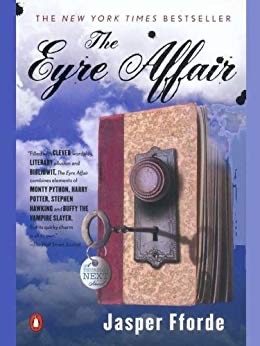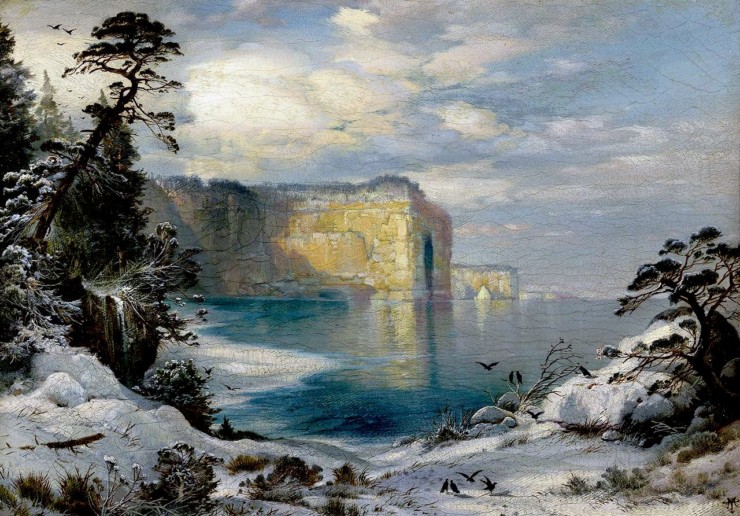She cried out in fear as the sky and the lake met; the daffodils, trees and clouds returning to their place in the poem, individual words, sounds, squiggles on paper with no meanings other than those with which our own imagination can clothe them. She let out one terrified scream as the darkness swept on and the poem closed on top of her.”
In this scene a woman has become trapped in William Wordsworth’s poem I Wandered Lonely as a Cloud. She’s transported into the poem through a nifty machine and meets an old man in a black cloak, who is Wordsworth. He speaks mostly in lines of the poem while adding a bit of his own personal gloom. This place is a paradise for her, a purgatory for him. Then something goes wrong and the woman becomes trapped in the poem.
It’s not the worst poem to be trapped inside. How would you like to be trapped in William Stafford’s A Ritual to Read to Each Other, along with those poor, lost elephants?

The copy of Jane Eyre that Tamworth had given me had saved my life. I had placed it in my breast pocket.”
Our heroine placed the book right next to her heart, so of course it saved her (in this case, from a bullet). But it also saved her emotional heart. It kept her going until love was ready for her and she was ready for love.
That’s why we read: to be saved.
In between The Eyre Affair’s many jokes meant to delight English majors like myself, I appreciated the way the story smushed book reality with real reality. How would our world be different if Jane had married St. John Rivers instead of Edward Rochester? Would we, the readers and lovers of Jane Eyre, somehow be different? Or to put it another way, what happens if the elephant in front of us wanders? Are we then truly lost?
On New Year’s morning my husband I were discussing a story that in the world of The Eyre Affair would surely be on the bad guy’s hit list: Little Women by Louisa May Alcott. The end of the movie plays with the line between fiction — Jo March marrying Friedrich Bharer — and reality — Louisa May Alcott marrying no one, ever. That line is a bit fuzzy, as we learn in The Eyre Affair:
The barriers between reality and fiction are softer than we think; a bit like a frozen lake.”
Reading a book or a poem is like falling through soft ice. Plots and characters and elephants and daffodils become part of who we are. Each time we read, we plunge into the invigorating slush. And each time we are saved.
Maybe not from a bullet, but then again, you can never be too careful. Keep your classics close to your heart.
January Pages
Finished
Poetry
The Boat of Quiet Hours, Jane Kenyon (I spent more time with this one, as is evidenced in this post about Kenyon and Sara Teasdale.)
Tropic of Squalor, Mary Karr
Adult
Sense & Sensibility, Jane Austen
The Great Silence, Ted Chiang (Short story I will return to for Poetic Earth Month.)
Sun Shine Down, by Gillian Marchenko (a Tweetspeak title)
Pale Horse, Pale Rider, Katherine Anne Porter (Three short novels. Porter did not care for the word “novella.”)
Early Readers and Picture Books
The Dinosaur Tooth Fairy, by Martha Brockenbrough, illus. Israel Sanchez
Katy and the Big Snow, Virginia Lee Burton
Middle Grade and YA
Sun and Moon, Ice and Snow, Jessica Day George
Junie B. Jones and the Mushy Gushy Valentime, by Barbara Park (Join us for Children’s Book Club, next Friday, Valentine’s Day.)
The Silver Chair, by C.S. Lewis (Patron-only book club starts February 12)
The Cricket in Times Square, George Selden, illus. Garth Williams
Made Progress
Little Women, Louisa May Alcott
Photo by Thomas Moran, Creative Commons, via Flickr. Post by Megan Willome.
Browse more A Ritual to Read to Each Other
“Megan Willome’s The Joy of Poetry is not a long book, but it took me longer to read than I expected, because I kept stopping to savor poems and passages, to make note of books mentioned, and to compare Willome’s journey into poetry to my own. The book is many things. An unpretentious, funny, and poignant memoir. A defense of poetry, a response to literature that has touched her life, and a manual on how to write poetry. It’s also the story of a daughter who loses her mother to cancer. The author links these things into a narrative much like that of a novel. I loved this book. As soon as I finished, I began reading it again.”
—David Lee Garrison, author of Playing Bach in the D. C. Metro
- Perspective: The Two, The Only: Calvin and Hobbes - December 16, 2022
- Children’s Book Club: A Very Haunted Christmas - December 9, 2022
- By Heart: ‘The night is darkening round me’ by Emily Brontë - December 2, 2022


Glynn says
It may have to do with my age, but I’m finding the classics to be much more engaging than when I was younger. Right now, I’m rereading a modern classic — The Lord of the Rings trilogy. It’s my fourth time through the world of Middle-earth, and it is a wonderful story.
January reading
Fiction
Finding Love in Florence by Shanna Delaney
Roseberry Topping; Thornaby Accident & Other Stories; and Nightmare Waiting & Other Stories, all by Glenn McGoldrick
Love’s Thankful Hearts – Three Novellas
The Way We Were Before by Moshe Marcus
Mystery
Gone Too Soon by Scott Hunter
Flotsam and Jetsam by Keith Moray
The Georgie Murder by Roy Lewis
Non-fiction
The Prison Meditations of Father Alfred Depp
How Not to Teach American History by D. Duvenport and G. Lloyd
Tolkien’s Lost Chaucer by John Bowers
The Man Who Played with Fire by Jan Stocklassa
On the Shoulders of Hobbits by Louis Markos
The Ten Commandments of Progressive Christianity by Michael Kruger
Plays
Heroes of the Fourth Turning by Will Arbery
Poetry
Voices on the Wind by Daniel Leach
Megan Willome says
Glynn, I suspect that as we get older we can engage with old stories in ways we couldn’t when we were younger. And there’s something about reading them for pleasure, without worrying about being tested or what big paper is expected.
Maureen says
My arts ministry and an upcoming show I put together (‘Contemporary Artists Interpret Stations of the Cross’) have kept me very busy but I am deep into the wonderful Eric Metaxas biography of Dietrich Bonhoeffer and in the last third of the collected poems of Jane Mead. I completed my reading of ‘Say Nothing’, an excellent book about Ireland during ‘The Troubles’; it may be the best I’ve read on the subject. My copy of the anthology ‘Is It Hot in Here or Is It Just Me?’ came the other day; it contains some wonderful essays as well as poems. (I’m pleased to say I have a poem in it.)
While I haven’t been re-reading the classics, I did go see the new ‘Little Women’ and thought it was excellent.
Megan Willome says
Maureen, I thought so too! That’s why I picked up the original again, which I’ve read more times than I can count, but now I can picture the actors from the current film as I read.
Congrats on having a poem in the new collection.
I went to Northern Ireland in 2012 and learned how much I didn’t know about The Troubles. I’m also a fan of “Derry Girls,” set in that time.
Will Willingham says
What a great book this sounds like. Megan, is it one that a person could enjoy (though, yes, of course, not as much) without having read the original texts, or would it turn out to be a little too insider? (If the former, even more impressive, as I can imagine there is quite a skill to contextualize these things without bogging down the story.)
Megan Willome says
At least for this one (the Thursday Next novels are a series), there was a lot of context provided, by way of explanation. Of course, having just read “Jane Eyre” again a few months ago, I picked up on a lot of insider things, but I’ve never read “Martin Chuzzlewit” and I still got the gist of it. I learned Wordsworth’s poem by heart, but even if I hadn’t, I’d have known there was some important poem out there about daffodils, which is enough to enter into the story.
I’ll definitely read more in the series. Quite bizarre and very British humor, but just fun stuff.